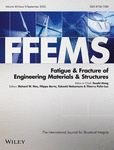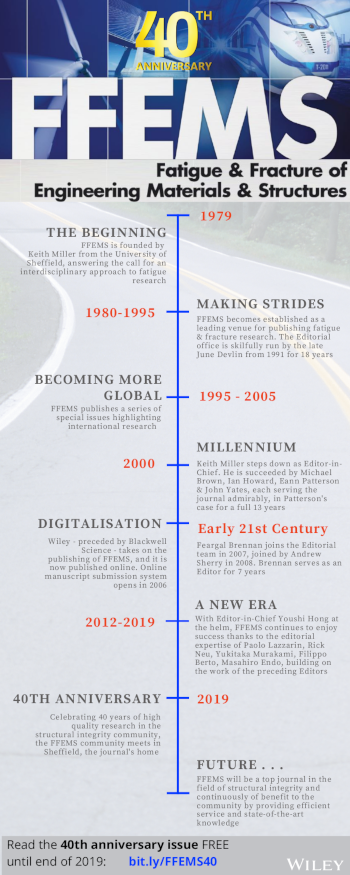Journal list menu
Export Citations
Download PDFs
ISSUE INFORMATION
ORIGINAL ARTICLES
Edge tracing technique to study post-necking behavior and failure in Al alloys and anisotropic plasticity in line pipe steels
- Pages: 2427-2442
- First Published: 07 June 2022
- Radial deformation in tensile specimens before and beyond necking can be accurately estimated via images recorded during testing: Edge Tracing Method (ETM).
- ETM helps in assessing failure and calibrating GTN damage parameters.
- ETM method allows evaluating continuously the plastic anisotropy in line pipe steels which is essential for fracture analysis in anisotropic materials.
- Isotropic and anisotropic elastic–plasitc hardening laws can be fit without the Bridgman correction thanks to the ET technique.
Railway wheelset fatigue life estimation based on field tests
- Pages: 2443-2456
- First Published: 01 June 2022
Different effects of multiscale microstructure on fatigue crack growth path and rate in selective laser melted Ti6Al4V
- Pages: 2457-2467
- First Published: 02 June 2022
- Heat treatments at two temperatures were used to eliminate SLM features.
- The morphology of the α phase affected the fatigue crack growth path and rate.
- The strength-toughness relationship can help to understand the variation of FCG rate.
Modelling fatigue uncertainty by means of nonconstant variance neural networks
- Pages: 2468-2480
- First Published: 12 June 2022
- Probabilistic neural networks with nonconstant variance are used to model fatigue.
- Two case studies are presented to demonstrate the developed approach.
- The proposed method accurately models fatigue and accounts for aleatoric uncertainty.
On the effect of confining pressure on fatigue failure of block-in-matrix soils exposed to multistage cyclic triaxial loads
- Pages: 2481-2498
- First Published: 08 June 2022
- Fatigue failure of bimsoil under multi-level cyclic loads was experimentally investigated.
- Strain softening to strain hardening for bimsoil is found as confining pressure increases.
- Strong volumetric dilatancy occurs earlier for a bimsoil under low confining pressure.
- CT imaging reveals multiple interface cracking and volumetric dilatancy behaviors.
A double-clipping method to achieve the fatigue damage equivalence between uniaxial and triaxial random vibrations
- Pages: 2499-2515
- First Published: 07 June 2022
- A double-clipping method is proposed to provide a valuable reference for supplementing the triaxial test standard.
- Three selection criteria for equivalent component are designed.
- The clippings on test time and load spectrum are shown through two examples.
Incorporation of high-altitude environmental effects in the linear elastic fracture mechanics-based modeling of aluminum alloy 7075
- Pages: 2516-2530
- First Published: 12 June 2022
- Applying low water vapor pressure fatigue growth rates extended fatigue life in LEFM modeling.
- When applied to in-service loading spectrum for aerospace applications, this extension was maintained.
- Subtleties with environment loading and fatigue life were investigated.
Evaluation of local stress-based fatigue strength assessment methods for cover plates and T-joints subjected to axial and bending loading
- Pages: 2531-2548
- First Published: 15 June 2022
Fatigue behaviors of a titanium alloy in the VHCF regime based on a vibration-based bending fatigue test
- Pages: 2549-2562
- First Published: 13 June 2022
Design of a novel creep testing machine to investigate the creep life history of austenitic steel foil at elevated temperature
- Pages: 2563-2575
- First Published: 04 July 2022
- Novel testing machine and method to measure the creep deformation of metal foils.
- Creep behavior of AISI 347 steel foil under various stresses at laboratory air and in argon environments.
- The use of shielding inert gas and its capability to protect the foil surfaces from oxidation.
- Stablish relationship between the creep life and axial creep conditions using modified theta projection concept.
Macro-meso fatigue damage and instability of a fault bimrock exposed to multistage cyclic triaxial loads with different confining pressure
- Pages: 2576-2594
- First Published: 19 June 2022
- Damage and instability of a fault bimrock under cyclic triaxial loads was investigated.
- The volumetric strain rate can early issue an warning than the volumetric strain
- An inverted “L” and “S” shaped damage evolution pattern were revealed and modelled.
- Post-test CT scanning reveals improvement of skeleton effect of blocks.
Experimental study on cracking behaviors of coarse and fine sandstone containing two flaws under biaxial compression
- Pages: 2595-2612
- First Published: 19 June 2022
- The damage characteristics and the fracture mechanism of coarse and fine sandstone are revealed.
- The distribution characteristics of two AE indexes are employed to qualitatively reveal the failure mechanism.
- Electron Probe Microscope Analysis technique is conducted to observe the main macrofracture surfaces of sandstone.
- The ultimate failure modes of coarse and fine sandstone specimens are investigated.
A nonlinear uniaxial fatigue damage accumulation model based on the theory of material configurational forces
- Pages: 2613-2629
- First Published: 29 June 2022
- A nonlinear damage accumulation model under uniaxial fatigue is proposed.
- The configurational force is introduced as an internal variable to describe the damage.
- The numerical results of the proposed model show adequate accuracy.
Fatigue behavior and electromechanical properties of additively manufactured continuous wire polymer composites for structural health monitoring
- Pages: 2630-2645
- First Published: 29 June 2022
Experimental study on fracture properties of dam concrete under post-peak cyclic loading based on DIC and acoustic emission techniques
- Pages: 2646-2661
- First Published: 01 July 2022
SI CONTRIBUTIONS – FATIGUE 2021
Fracture mechanics and hot spot stress-based fatigue life calculation: Case study for a crane runway girder
- Pages: 2662-2675
- First Published: 23 May 2022
The influence of corrosion pit–pit spacing on the pit-to-crack transition and fatigue lifetime
- Pages: 2676-2692
- First Published: 07 June 2022
- Specimens containing twin pre-pits were high cycle fatigue tested in an air environment.
- Pit–crack transition is dependent on a threshold separation distance between the twin pits, stress range, and pit depth.
- The influence of pit–pit proximity is due to mechanical interaction effect.
- The implications from a structural integrity assessment viewpoint are discussed.
Detection of small internal fatigue cracks in Ti-6Al-4V via synchrotron radiation nanocomputed tomography
- Pages: 2693-2702
- First Published: 15 June 2022
- Small internal cracks with local microstructure were observed using nano-CT in Ti-6Al-4V.
- Both surface and internal small cracks in Ti-6Al-4V initiated from the alpha phase.
- Surface cracks tips are sharper and more sensitive to external load than internal crack.
- Internal cracks have similar crack opening behaviors to those of cracks in a vacuum.
SI CONTRIBUTIONS – FATIGUE MACHINE LEARNING
Experimental investigations and damage growth modeling of EN-AW 2024 aluminum alloy under LCF loading accounting creep pre-deformation
- Pages: 2703-2720
- First Published: 19 June 2022
- Experimental investigations of creep-rupture, creep and LCF of EN AW 2024 aluminum alloy were carried out
- A simply model of the damage growth during creep has been proposed
- The accumulation of LCF damage was modeled for as-received and pre-deformed material
- Verification of LCF damage growth model using experimental data was carried out
Modeling of fatigue failure mode in U-rib to deck joints in orthotropic bridge structures
- Pages: 2721-2733
- First Published: 27 June 2022
- The master S-N curve method is employed for capturing typical failure modes of OBD.
- Anti-fatigue performance variations between double- and single-sided joints are studied.
- A parameterized analysis of weld penetration and fillet size effects is conducted.
Effect of the porosity on the fatigue strength of metals
- Pages: 2734-2747
- First Published: 05 July 2022
- A procedure for fatigue assessment of metals with solidification defects is employed.
- The fatigue behavior of a DCI with a relevant micro-shrinkage porosity is analyzed.
- A defect content analysis is performed by means of a statistical method deriving from EVT.
- The return period is computed by a relationship that optimizes the procedure accuracy.
Fatigue life prediction in presence of mean stresses using domain knowledge-integrated ensemble of extreme learning machines
- Pages: 2748-2766
- First Published: 14 July 2022
- A data-driven model is proposed for fatigue life prediction under mean stress conditions.
- The model is hybridized with domain knowledge.
- The model is more accurate and stable compared with several existing mean stress models.
- The model has less dependence on the size of training data.





